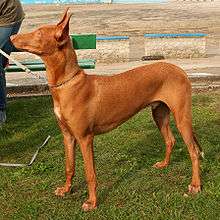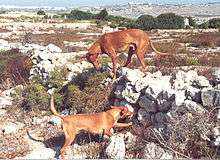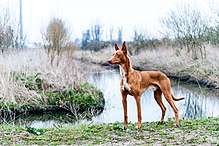Pharaoh Hound
The Pharaoh Hound is a Maltese breed of hunting dog. In Maltese it is called Kelb tal-Fenek, which means "rabbit dog"; it is traditionally used for hunting rabbit in the rocky terrain of the Maltese Islands.[1] It is classified by the Fédération Cynologique Internationale in its "Spitz and primitive" group, and shows similarities to other Mediterranean breeds in that group such as the Cirneco dell'Etna, the Podenco Andaluz, the Podenco Canario, the Podenco Ibicenco and the Portuguese Podengo. It is the only Maltese dog breed with international recognition.[lower-alpha 1]
| Pharaoh Hound | |||||||||
|---|---|---|---|---|---|---|---|---|---|
 | |||||||||
| Other names | Maltese: Kelb tal-Fenek | ||||||||
| Origin | Malta | ||||||||
| |||||||||
| Notes | National dog of Malta | ||||||||
| Dog (domestic dog) | |||||||||
DNA study
A DNA analysis of the Pharaoh Hound and the Cirneco dell'Etna of Sicily indicate that their separate breed formation occurred within the last 200 years, however the genetic foundations of these breeds date to the more distant past.[2]
History

The Kelb tal-Fenek is a traditional breed of rural Malta. As the English-language exonym suggests, it is sometimes claimed that the Pharaoh Hound descends from the dogs shown in the tomb paintings of Ancient Egypt.[3] A recent DNA study suggests that the breed is not of ancient origin, but a moderately recent development from various other breeds.[4]
In 1647 Giovanni Francesco Abela, in his Della Descrittione di Malta isola nel Mare Siciliano: con le sue antichità, ed altre notizie, wrote "... we have the dogs called Cernechi, much valued for rabbit-hunting, which are often in demand as far away as France, mainly for [use in] steep and stony mountain terrain".[5] Some have taken this to refer to the Kelb tal-Fenek.[6] The modern Cirneco is a Sicilian breed of similar structure and appearance to the Kelb tal-Fenek, but somewhat smaller (43–51 cm (17–20 in)).
The first litter to be born outside Malta was in the United Kingdom in 1963.[7] The breed was accepted by the Fédération Cynologique Internationale as the "Pharaoh Hound" in the same year, under the patronage of the UK.[8] A breed standard was approved by the British Kennel Club in 1974.[7]
Appearance

At first glance, the Pharaoh Hound appears both graceful and elegant as well as powerful and athletic. Its build is one of strength without bulkiness or excessive musculature. Its head is elegant without being fine or extreme. The skull resembles a blunt wedge, and is long and chiseled with only a slight stop and a snout of good length. Its eyes are oval with a keen, alert, and intelligent expression. Their eyes are commonly amber-coloured. It has a long, lean, and muscular neck that is slightly arched. It has a deep chest that extends down to the elbows and a moderate tuck up. Its shoulders are long and well laid back. Its front legs are long and straight. The back legs are moderately angled, parallel to each other, and must be balanced with the forelegs. It has a long, fine, straight tail that reaches down to a bit below the point of the hocks, and has a whip-like shape. The tail is carried down when relaxed. When the dog is in motion or is excited, the tail is carried up; either level with, or loosely curled above, the back. Its dewclaws may be removed. The Pharaoh Hound's ears are very large and point upward when alert. They usually come in tan or chestnut colors. A white tail-tip is admired. Most commonly seen is any solid white spot on their neck, back, or shoulders. Mainly seen on the back or sides of the dog.[9]
The coat is fine and short with no feathering. The texture varies from silky to somewhat hard and it must never be so profuse as to stand away from the dog's skin. The coat can also be glossy and short in most cases.[9] The only colour accepted by most kennel clubs is red; though the shades of red colour varies, and accepted shades range from a tan to a deep chestnut and all shades in between. White markings on the chest, toes, tail-tip, centre of forehead, and the bridge of the muzzle are accepted, but not required. Pharaoh's eyes are always amber, and should complement the coat colour. They are born with blue eyes, which change to a light gold or yellow colour during early puppyhood and then begin to darken well into adulthood. The nose, whiskers, nails, paw-pads, and eye-rims should also be the same colour as the coat. Pharaoh Hounds also have a unique trait of "blushing" when excited or happy, with their ears and noses becoming bright pink.[10][9]
Health
The Kelb tal-Fenek suffers from few genetic diseases.[11] Life expectancy is about 12 to 14 years.[11][12]
Hunting
.jpg)
The Kelb tal-Fenek is usually taken out to hunt at night when there are fewer distractions. Generally, the hunters will take their dogs into the countryside and release pairs of a male and a female dog in each compass direction. The dogs will then search out their prey using scent. When a rabbit is found the hounds will give chase, the small and more agile female in the lead with the male keeping the rabbit from darting too far to the sides. At this point the dogs giving chase will emit a high pitched bark, attracting the other dogs and the hunters, all of whom will come running. By the time the hunters and other dogs arrive the rabbit will almost always have taken to the ground. The hunters will then gather and leash all but one dog, then place nets over all of the likely escape holes of the rabbit. Finally the hunter will take a ferret (with a small bell attached) from a round wicker basket, and places it into the last entrance to the rabbit's burrow. The Kelb tal-Fenek can hear the little bell up to 3 metres down under the rocky terrain. When the ferret flushes the rabbit out a hole, one free dog swoops down upon it. The use of ferrets is mentioned by Strabo about rabbit-hunting in the Balearic Islands under Roman rule.[13][14][15][16]
Miscellaneous
The Kelb tal-Fenek is not the only breed of dog specific to the tiny islands of Malta. There is also the Kelb tal-But ("pocket dog", a toy breed), Kelb tal-Kaċċa ("hunting dog", a breed used for bird hunting), and lastly a type of Mastiff which is now extinct (Kelb tal-Ġlied, sometimes called the Maltese Bulldog or Maltese Mastiff). It is number 141 out of 154 breeds by dogs registered in 2005 by the AKC.[17]
Notes
- The Maltese toy dog breed has no verified connection with the Maltese islands.
References
| Wikimedia Commons has media related to Pharaoh Hound. |
- "Kelb tal-Fenek - National Hound of Malta". Kelb-tal-fenek.de. Archived from the original on 27 January 2012. Retrieved 16 November 2011.
- Talenti, Andrea; Dreger, Dayna L; Frattini, Stefano; Polli, Michele; Marelli, Stefano; Harris, Alexander C; Liotta, Luigi; Cocco, Raffaella; Hogan, Andrew N; Bigi, Daniele; Caniglia, Romolo; Parker, Heidi G; Pagnacco, Giulio; Ostrander, Elaine A; Crepaldi, Paola (2018). "Studies of modern Italian dog populations reveal multiple patterns for domestic breed evolution". Ecology and Evolution. 8: 2911–2925. doi:10.1002/ece3.3842. PMC 5838073. PMID 29531705.
- "About the Breed". Pharaoh Hound Club of America. 2013.
- Parker, Heidi. et al. 2004 “Genetic Structure of the Purebred Domestic Dog”. Science 304, 1160
- Giovanni Francesco Abela (1647). Della Descrittione di Malta isola nel Mare Siciliano: con le sue antichità, ed altre notizie. Malta: Paolo Bonacota. pp. 129–30. "... habbiamo i cani chiamati Cernechi[,] molto stimati per la caccia al coniglio, che in fin dalla Francia sono richiesti ben spesso con molta istanza massimamente per i luoghi sassosi alpestri, e scoscesi"
- Cecil S. Camilleri (1995). "A Study of the Maltese Kelb tal-Fenek". Valletta, Malta: Progress Press.
- Jan Scotland (20 July 2004). The national dog of Malta. Times of Malta. Accessed March 2020.
- Pharaoh Hound (248). Fédération Cynologique Internationale. Accessed March 2020.
- Coile, Caroline (2005). Encyclopedia of Dog Breeds (second ed.). Barrons. p. 352. ISBN 0-7641-5700-0.
- Frequently Asked Questions
- "FAQ". Pharaoh Hound Club of America. Retrieved 4 July 2014.
- "Summary results of the Purebred Dog Health Survey for Pharoah Hounds" (PDF). The Kennel Club. The Kennel Club/BSAVA. Retrieved 4 July 2014.
- The Domestication and Exploitation of Plants and Animals By Peter Ucko, G. Dimbleby, 2007 - p. 489
- A Study of the Maltese Kelb-tal-Fenek, Cecil Camilleri, Progress Press Co Ltd (30 June 1995)
- Rabbit Hunting with the Kelb tal-Fenek in Malta
- Il-Kelb tal-Fenek - A Fieldwork Description
- "AKC Dog Registration Statistics". Archived from the original on 11 May 2012. Retrieved 10 December 2006.